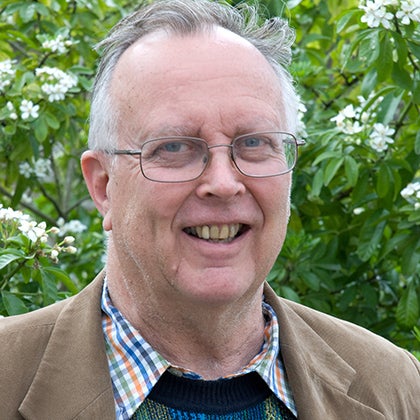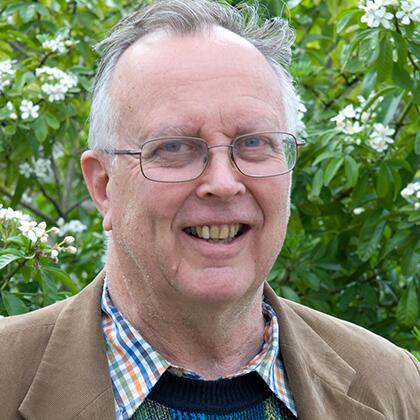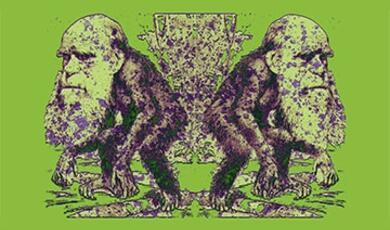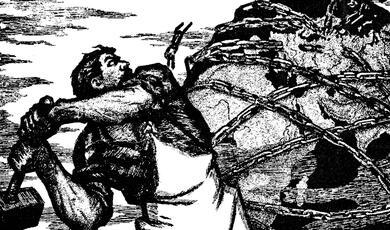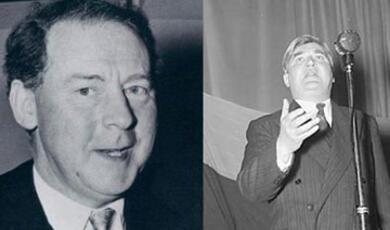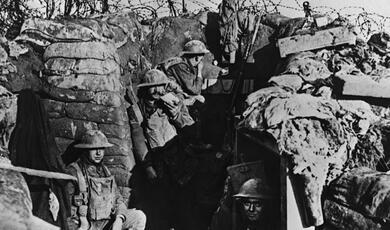Edmond Halley (1727): On the Shoulders of Giants
Share
- Details
- Text
- Audio
- Downloads
- Extra Reading
Edmond Halley presents a lecture about his friend, Sir Isaac Newton.
Download Text
Edmond Halley (1727): On the Shoulders of Giants
Professor Robin Wilson
Ladies and Gentlemen,
It is difficult to believe that the great Isaac Newton is with us no longer. His death, just a few weeks ago, was the signal for much pomp and pageantry, and a wealth of poems, statues, medallions and other commemorations are even now beginning to appear.
No person ever reached higher than Isaac Newton his achievements remain unsurpassed. There is only one universe, and it could thus be given to only one person to discover its fundamental law, the universal law of gravitation. This law was expounded by Sir Isaac in his Principia Mathematica, the greatest highth of Knowledge that humane nature has yet arrived to, as the antiquarian John Aubrey has asserted, and I feel deeply honoured to have been so closely associated with its production over forty years ago.
Indeed, as I wrote in my Ode prefixed to the Principia:
Lo, for your gaze, the pattern of the skies!
What balance of the mass, what reckonings
Divine! Here ponder too the Laws which God,
Framing the universe, set not aside
But made the fixed foundations of his work. . .
Then ye who now on heavenly nectar fare,
Come celebrate with me in song the name
Of Newton, to the Muses dear; for he
Unlocked the hidden treasuries of Truth:
So richly through his mind had Phoebus cast
The radiance of his own divinity.
Nearer the gods no mortal may approach.
Isaac Newton was born on Christmas Day 1642 in this house in the tiny hamlet of Woolsthorpe, in the county of Lincolnshire, just seven miles south of Grantham. His father, a yeoman farmer, had died three months earlier, and the young Isaac, born very prematurely, was not expected to survive, being so small (it is said) that he could be fitted into a quart pot. When he was just three years old, his mother remarried and moved away, leaving him to be cared for by his grandmother, a situation that the young Isaac always resented bitterly.
It was, however, a good time for a scientist to be born, as the world of science had been overturned during the previous century. In 1543 Copernicus had published his book On the revolution of heavenly spheres, in which he replaced the earth-centred planetary system of the ancient Greeks (the Ptolemaic system) by one with the sun at the centre, and the earth as just one of several planets in circular orbits around it.
The Copernican system was highly controversial bringing its proponents into direct conflict with the Church, who considered mankind to be at the centre of everything. The idea that the earth was just one of several orbiting planets was nothing short of heretical, and the Italian Giordano Bruno was burnt at the stake for supporting it. Even the great Galileo, the astronomer who first discovered the moons of Jupiter and Saturn using the newly-invented telescope, got into serious trouble. He wrote a book in 1632 describing the advantages of the Copernican system over the Ptolemaic one, and was subsequently brought in front of the Inquisition and forced to recant. Galileo died in 1642, the year of Newtons birth.
Also featuring in our story is the German mathematician and astronomer Johannes Kepler. Using extensive astronomical data from the great Danish observer Tycho Brahe, Kepler proposed three laws of planetary motion. Two of these are that the planets orbit the sun in ellipses, rather than circles, with the sun at one focus (the word focus was actually introduced by Kepler), and that the planets trace out equal areas in equal times. This means that whether the planet is travelling fast near the sun, or travelling slowly far away, the areas of sky traced out in a fixed period of time are equal. Keplers laws were based on observation; it was to be Newton, some eighty years later in the Principia, who explained why they were true.
But although Isaac Newton was born at a propitious time for science, it was a turbulent period in English history. Charles I, who had been on the throne since 1625, believed in the divine right of Kings that kings were sent by God and that their pronouncements were sanctioned from on high. This led to a very unsettled period during which Charles dismissed his parliament, leading eventually to the outbreak of the Civil War in 1642 (the year of Newtons birth) and the eventual rise of Oliver Cromwell. In 1648 King Charles was placed on trial for treason, and was publicly beheaded in Whitehall on 30th January 1649 the only English monarch ever to have been executed.
Following the death of his stepfather, Isaac (aged 12) was sent to Grantham to board with a local apothecary and attend the Free Grammar School of King Edward VI, shown here. In his schoolroom he learned mathematics and the sciences from his teacher, the excellent Henry Stokes. It is said that he devoted much energy to performing ingenious experiments and to the construction of mechanical models, such as a model windmill that could actually grind flour, being powered by a small mouse.
When Isaac left school at the age of 17 and returned to Woolsthorpe, it soon became apparent that a farming career was unsuitable for him. Indeed, the story is told that he was leading a horse up a hill, when the horse slipped its bridle and ran off. Isaac, completely engrossed in some mental calculations, failed to notice and walked on regardless.
So he returned to Grantham to lodge with Mr Stokes and prepare himself for studying at Cambridge University in his uncles college, Trinity. In his personal notebook from this time the young Isaac recorded his purchases a stilton cheese for 2s, a chamber-pot for 2s 2d, and one shilling for a table to jot down the number of my cloathes in the wash.
Isaac Newton arrived at Trinity College in June 1661, where he became part of a community of some 400 students and scholars. Not being one of the landed gentry, he began as a subsizar, earning his keep by serving the Fellows and the wealthier students, waiting at table, cleaning boots and emptying chamber-pots. In 1664 he became a scholar and was able to give up these menial tasks.
Other events
Before I describe Newtons scientific studies in Cambridge, it is helpful to digress and consider the scientific events that were happening elsewhere. At Gresham College, in London, the first six Professors of Geometry had all been Oxford men, starting with Henry Briggs, and the first four Gresham Professors of Astronomy were similarly Oxford men; this link between London and Oxford would prove to be of great importance in the coming years, as we shall shortly see.
Meanwhile, in Oxford itself, the Royalist professors had been replaced by those sympathetic to the Parliamentarian cause; in particular, the Savilian Chairs of Geometry and Astronomy were filled by two Cambridge men John Wallis, pictured here, and Seth Ward. Wallis had deciphered secret codes for Cromwell during the Civil War and had became enthusiastic about mathematics after reading a celebrated algebra text of William Oughtred. However, Wallis had little mathematical experience, and enjoyed no public recognition as a mathematician. As he himself remarked:
In the year 1649 I removed to Oxford, being then Publick Professor of Geometry, of the Foundation of Sir Henry Savile. And Mathematicks which before had been a pleasing diversion, was now to be my serious Study.
A mathematical appointment on flimsier evidence is hard to imagine, and yet Wallis established Oxford as the centre for mathematical activity while he himself became the most influential of English mathematicians before the rise of Newton.
In the 1650s, Wallis wrote several much-admired works. One of these was De sectionibus conicis, on the geometrical properties of the conic sections the parabola, ellipse and hyperbola, known since Greek times. In this book the mathematical symbol for infinity appeared for the first time. Another was Walliss Arithmetica infinitorum, in which he obtained his celebrated product formula for p and introduced the mathematical expression interpolation. This work was to influence Isaac Newton during his studies at Cambridge, as you will see.
The scene now moved to Wadham College in Oxford, where an informal group of highly talented Oxford individuals gathered under the Wardenship of John Wilkins, who had been appointed in 1648. Wilkins had written a number of books relating to science, such as one defending Galileo and popularising the Copernican system of planetary motion, and another entitled Mathematical magick, in which he showed how to uproot an oak tree by gearing up a breath of wind.
Under Wilkins, Wadham became the centre of Oxfords experimental philosophy school in the 1650s. This school rejected the scientific theories of Aristotelian physics, studied in the universities, in favour of the recent experimental views of Francis Bacon and others. Here, advances in science were to be based on a blend of scientific experiment and theorising, in which hypotheses were tested by taking measurements and refined accordingly. Bacons Great Instauration of 1620 had shown a ship sailing into the great unknown beyond, with the slogan Many shall pass through and knowledge will increase. Bacon was not himself a great experimenter. Indeed, his most famous experiment concerned refrigeration, in which he stuffed a chicken full of snow; sadly, the result of this experiment was that he caught pneumonia and died.
The distinguished members of the experimental philosophy school included John Wallis, the great Robert Boyle, Robert Hooke and Christopher Wren. Boyle had come to Oxford at the invitation of Wilkins in the mid-1650s, and in his laboratory in High Street he discovered the gas-pressure law now known as Boyles law. He also carried out experiments with his air pump, designed by his assistant Robert Hooke for the purpose of obtaining a vacuum. In 1663 he demonstrated the asphyxiation of a cat by the evacuation of the pump:
To the Danish Agent late was showne
That where noe Ayre is, theres noe breath.
A glasse this secret did make knowne
Where[in] a Catt was put to death.
Out of the glass the Ayre being screwed,
Pusse died and neer so much as mewed.
Robert Hooke was the greatest experimenter of his age possibly of all time. While in Oxford he became interested in the design of accurate clocks and watches, and through these investigations obtained his famous law on the extension of springs Hooke's law, that the tension in a spring is proportional to its extension. An extract from his diary records a visit to a coffee house where he told Christopher Wren of his latest researches into springs. Hooke was also the inventor of the microscope, and wrote a celebrated text on it, called Micrographia, for which Wren provided the drawings.
Christopher Wren had been an undergraduate at Wadham in the early 1650s and then followed a distinguished career, becoming successively Gresham Professor of Astronomy in London and Savilian Professor of Astronomy at Oxford. He is now remembered as an architect mainly as a result of the Great Fire of London in 1666 which destroyed four-fifths of the old City of London; the fire-fighting equipment was less than adequate. Wren designed about sixty new churches, the most famous of which is of course St Pauls Cathedral, completed in 1708 when he was 90 years old.
One of the earliest buildings he designed was the Sheldonian Theatre in Oxford, famous for its flat 80-feet by 70-feet ceiling.
In 1660, some time after the death of Oliver Cromwell, Charles II returned in triumph to England, and the puritan restrictions were soon removed. In London the arts flourished, with restoration plays and comedies by John Dryden and others, later set to music by Henry Purcell. Sports were re-introduced, such as the game of tennis, and the recent arrival in England of the new drinks, tea and coffee, led to the London coffee houses, in which artists and intellectuals gathered to talks about the latest scientific and literary works. John Milton, in particular, was shortly to produce his Paradise Lost.
Scientific experiments were presented at the newly-founded Royal Society, to which Charles II gave the Royal Charter in 1662, inspired by the scientific academies in Paris and Rome. The Societys early members comprised members of the Oxford experimental philosophy school such as Wren (who gave the first lecture), Wallis, Boyle and Hooke together with prominent London figures such as John Dryden and Samuel Pepys, Minister for the Navy. Pepys was interested in science and visited Oxford to see Wrens Sheldonian Theatre and Roger Bacons observatory:
So to Friar Bacons study: I up and saw it and gave the man a shilling. Oxford mighty fine place.
The Royal Society met at Gresham College, with Robert Hooke, as Curator of Experiments, designing and presenting new scientific experiments every week. It published the Philosophical transactions, the first scientific journal in the world, printed in English rather than Latin. Soon after, in 1675, Charles II founded the Royal Observatory at Greenwich, containing the famous Octagon Room that housed many of the best astronomical instruments of the day.
Newton in Cambridge
Meanwhile, in Cambridge, Isaac Newton was pursuing his studies at Trinity College. Largely ignoring the Aristotelian science still taught there, he embarked on an extensive course of reading which included the celebrated Appendix on Geometry, recently expanded and translated into Latin, of Descartes Discourse on method. He was also inspired by John Walliss Arithmetica infinitorum and while still an undergraduate, obtained the infinite series expansion of p + q raised to a rational power the first appearance of the infinite binomial theorem.
While at Trinity he discussed mathematics and optics with Isaac Barrow, the first Lucasian Professor of Mathematics at Cambridge and at the time also Gresham Professor of Geometry. Barrow was succeeded at Gresham College by Robert Hooke who held the geometry Chair for 37 years.
Then disaster struck, with the Great Plague of 1665 in which up to 9000 people per week were dying in London. Cambridge University closed, and Newton returned to Lincolnshire where he spent his annus mirabilis, the miraculous year of 1666 in which he made fundamental advances in the calculus, optics and gravitation, while also working on chemical experiments and theology and also on music theory. (Incidentally, in spite of this Newton was not musical; on one occasion, hearing the great Handel playing the harpsichord, he could find nothing worthy to remark but the elasticity of Handels fingers.) Before I expand on Newtons annus mirabilis, let us hear Newtons own account of this remarkable period.
In the beginning of the year 1665 I found the Method of approximating series & the Rule for reducing any dignity of any Binomial into such a series. The same year in May I found the method of Tangents of Gregory and Slusius, & in November had the direct method of fluxions & the next year in January had the Theory of Colours & in May following I had entrance into the inverse method of fluxions. And the same year I began to think of gravity extending to the orb of the Moon & deduced that the forces which keep the planets in their Orbs must be reciprocally as the squares of their distances from the centres about which they revolve: & thereby compared the force requisite to keep the Moon in her Orb with the force of gravity at the surface of the earth, & found them answer pretty nearly. All this was in the two plague years of 1665-1666. For in those days I was in the prime of my age for invention & minded Mathematicks & Philosophy more than at any time since.
Newton gave the first proper treatment of the calculus. In this subject there are two distinct branches: differentiation (or fluxions, as Newton termed it) which concerns how things move or change with time; and integration (or quadrature), which is concerned with finding areas. Both of these seemingly unrelated processes had a long history, but several mathematicians of the 17th century (in particular, Isaac Barrow) suspected a connection between them that in fact they are inverses of one another. It was Isaac Newton during the plague years (and Leibniz, later working independently in Germany) who first explained why this must be so.
In optics he carried out experiments on the splitting of white light into its constituent colours. A drawing by Newton shows his crucial experiment in which sunlight is refracted through a prism and then just one colour is refracted through a second prism to show that it undergoes no further change.
It was also at this time that the celebrated incident of Newton and the apple tree supposedly happened. The story goes, which Sir Isaac recounted in his old age, that on seeing an apple fall, Newton hypothesised that the force pulling the apple to the ground is the same force a universal force that keeps the earth in orbit around the sun and the moon in orbit around the earth. And moreover, the universal law of attraction is an inverse-square law: the force of attraction is proportional to the product of the two masses, but inversely proportional to the square of the distance between them. Although Newton did not develop these ideas until twenty years later, the basic ideas were clear to him during the years of the Great Plague.
On his return to Cambridge in 1667, he was elected a Fellow of Trinity College and later became Lucasian Professor of Mathematics, replacing Isaac Barrow who wished to spend more time on theological matters. Newton spent much of this period working on optics. The refracting telescopes of the day were proving difficult to use, since the differing refraction of red and blue light through the telescopes lens caused a colouring around the edges of the image. Newtons solution was simple and effective: he replaced the lens by a mirror, thereby creating a reflecting telescope. For this, he was elected a Fellow of the Royal Society in 1672.
In the same year he published his researches into the nature of light in the Philosophical Transactions. This led to a lengthy and bitter dispute with Robert Hooke Newton never forgave Hooke for this. Three years later, Newton antagonised Hooke even further with his work on coloured rings the patterns that appear when two lenses are pressed together. Hooke had obtained good results on this, but Newton who had made his own optical equipment and had ground his own lenses obtained far more accurate ones. The circular pattern is now known as Newtons rings.
One other result of the 1670s is worthy of mention. It had been known for some time that an equation of the second degree involving terms in x2, y2 and xy is the equation of a conic: an ellipse, hyperbola or parabola. What happens if we consider equations of the third degree involving terms like x3, y3 or x2y? No-one else at this time would even consider trying to solve such a problem, but Newton did, finding all 78 possible types of curve a result years ahead of its time.
At this point I myself enter the story. I came up to Oxford University in 1673, at the age of 17, but interrupted my undergraduate studies to sail to St Helena to make the first accurate catalogue of the southern stars. For this I was elected a Fellow of the Royal Society on my return, and received my Oxford MA by order of the King.
In 1684 I was at the Royal Society, discussing with Christopher Wren and Robert Hooke whether an inverse-square law of force between the sun and a planet must necessarily produce an elliptical orbit. To clarify my thoughts I repaired to Cambridge to see Isaac Newton, and asked him directly what the orbit would be:
Sir Isaac replied immediately that it would be an ellipsis; the Doctor struck with joy and amazement asked him how he knew it. Why, said he, I have calculated it, whereupon Dr Halley asked him for his calculation without any further delay. Sir Isaac looked among his papers but could not find it, but he promised him to renew it, and then to send it to him.
In fact, I spent three years coaxing, cajoling and flattering Sir Isaac into producing the Principia. Worse, the Royal Society had no money to pay for it, having just produced an expensive History of fishes, so I agreed to print the work at my own expense. For my pains I received a gift from the Royal Society of fifty copies of the History of fishes, together with a further twenty copies as arrears of salary.
But the Principia was a triumph. It started with Newtons laws of motion, and then proceeded, in Book I, to prove the relationships between Keplers planetary laws and the inverse-square law. In Book II Newton investigated the motion of bodies in a resisting medium, such as water, and demolished a rival theory of planetary motion, Descartes so-called vortex theory. Finally, in Book III, The System of the World, he produced a torrent of results that followed from his gravitational theory finding the escape velocity necessary for a rocket to leave the earths atmosphere, explaining the theory of the tides, deriving the motion of comets, accounting for the precession of the equinoxes, and calculating the flattening of the earths surface at the poles due to the earths rotation.
After the Principia, nothing was ever quite the same again. Newton became a public figure, twice becoming Member of Parliament for Cambridge University (although his only public utterance was apparently to ask an official to open a window). Later he was appointed Warden, and then Master, of the Royal Mint, moving to London and living for a time in the Tower of London.
In 1703, following the death of Robert Hooke, Newton became the President of the Royal Society. The following year, with Hooke no longer on the scene, he published (in English) his celebrated and popular book on Opticks and in 1705 he was knighted by Queen Anne, the first scientist to be so honoured.
The rest of his long life he spent advising on scientific appointments, and I am sure that many of his followers owe their advancement to his helpful intervention. For myself, currently holding the positions of Savilian Professor of Geometry in Oxford (following the 54-year occupancy of John Wallis) and of Astronomer Royal (a position I have now held for seven years), I have often been grateful to Sir Isaac for his support and advice.
Newton once claimed that if he had seen further, it was by standing on the shoulders of giants. But Newton was himself a giant of the first magnitude. Sadly, he died earlier this year, at the great age of 84 here is his death mask and lay in state in Westminster Abbey for a week preceding his funeral. At the ceremony his pall was borne by two dukes, three earls and the Lord Chancellor. No previous scientist has ever been so honoured he will be sorely missed.
© Robin Wilson
This event was on Thu, 21 Nov 2002
Support Gresham
Gresham College has offered an outstanding education to the public free of charge for over 400 years. Today, Gresham College plays an important role in fostering a love of learning and a greater understanding of ourselves and the world around us. Your donation will help to widen our reach and to broaden our audience, allowing more people to benefit from a high-quality education from some of the brightest minds.


 Login
Login
